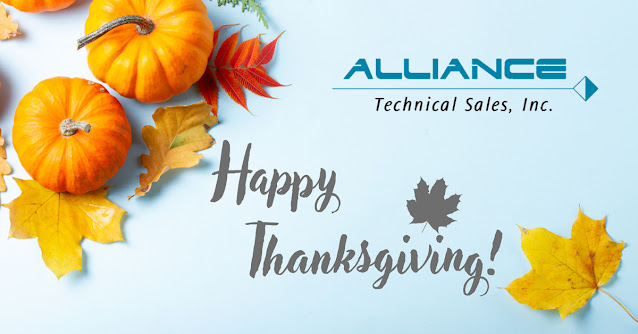An informative and educational resource specializing in process control instrumentation, analytical instruments, and related industrial equipment. Content includes technology basics, how-to's, new product developments, and application notes. Blog is courtesy of Alliance Technical Sales, a leading Manufacturers' Rep headquartered in Clarendon Hills, IL and serving customers in Illinois, Indiana, Iowa, Michigan and Wisconsin.
Winterization Tips for Your Building, Facility, or Industrial Plant
Anticipating freezing temperatures and safeguarding buildings, equipment, and materials from freeze damage are critical components of any annual property assessment. A solid freeze prevention plan comprises inspection, preventative maintenance, and corrective maintenance actions before the onset of cold weather.
Below are eighteen general freeze protection planning tips offered by application engineers and field experience comments. These procedures are not exhaustive, and we urge that you consult a professional before implementing your plan.
- Roof and Gutter: Inspect, remove debris, and patch/repair (if needed): roof drains, scuppers, canals, gutters, down spouts before first frost. Inspect and functionally test installed roof and gutter heat trace system. Apply heat in susceptible areas.
- Identify and test main water supply cutoffs for each facility. Ensure these areas are readily available to emergency personnel responding to a freeze/thaw incident. Apply heat in susceptible areas.
- Inspect wet‐pipe sprinkler systems for areas prone to freezing. Apply heat in susceptible areas.
- Identify materials that are subject to freeze damage in outside storage pads and unheated storage areas. Develop plan to ensure these materials can be easily heated and thawed to maintain production.
- Check and place antifreeze used in cooling systems as necessary.
- Protect heating system power and temperature controls against inadvertent deactivation.
- Inspect insulation on piping and vessels. Look for damage and vulnerable areas that might be exposed to freezing conditions. Add or replace insulation as needed.
- Drain and remove water from all seasonal cooling systems (unless protected by heating tapes or antifreeze).
- Inspect, test, and stage portable auxiliary heaters.
- Inspect conditions of all surface heaters such as heating tapes, heating cable, drum heaters, IBC heaters, tank heaters, and pipe heaters. Verify operation and temperature settings and test ground‐fault equipment protection. Replace as needed.
- Inspect, test, and repair heat trace heating cable located on cooling tower supply and return lines. Apply heat in susceptible areas.
- Inspect and identify remaining water and air lines subject to freezing. Install appropriate heat and insulation. Apply heat in susceptible areas.
- For steam systems: Blow down drip legs, clean strainers, test temperature sensing devices for actuation of control valves and dampers, check steam traps, control actuators/valves, face and bypass dampers, linkages, and temperature controllers. Ensure that a vacuum breaker is installed and in working order on all preheat and heating coils which may be exposed to freezing conditions.
- For ventilation systems: Test and calibrate all temperature sensing devices, and check operation of valves, dampers, linkages, control actuators, and temperature controllers.
- Identify areas where personal safety is at risk due to icy conditions. Develop a slip prevention maintenance plan. Apply heat in susceptible areas.
- Identify control panels and electronic devices susceptible to condensation. Install enclosure heaters to prevent short outs and corrosion.
- Institute a facility wide awareness plan to identify and report any suspected problems with heating or other cold weather protection equipment during the cold season.
- Special Consideration: Hazardous Materials
- Ensure that all containers used for hazardous or toxic materials are properly stored, and inspect them for deterioration prior to handling. If containers become brittle (due to the combination of chemical attack, freezing temperatures, and ultraviolet light) they may break when moved.
- Liquids should not be permitted to remain in unheated process lines during periods when production has been stopped. All lines should be drained and purged to prevent future line breakage due to freezing temperatures.
- Ensure that piping, tanks, and valves in systems that carry hazardous or toxic substances are properly insulated and/or heated. Install heaters such as heating blankets, insulators, heating tapes, heating jackets, and heating cable as appropriate.
Tips courtesy of BriskHeat. For more information on all BriskHeat products, contact Alliance Technical Sales. Call 630-321-9646 or visit https://alliancets.com.
ACURAGE™ Single Chamber Sight Glass with GWR from Hawk Measurement and Bliss Americas
Hawk Measurement and Bliss Americas Collaborate to Release the Industry's First Single Chamber Sight Glass with Guided Wave Radar.
The patented ACURAGE™ is the industry’s first auto-calibrating unique radar gauge for accurate level reading and instant spot smart calibration. Proudly made in the USA, this unique, ASME-approved level measuring instrument displays the level of process fluids in real-time via a digital display and built-in sight glass tube. The ACURAGE™ features a built-in safety ball check system to protect the operator from accidental spillage of process liquid in the unlikely event of glass breakage.
For more information, contact Alliance Technical Sales. Call 630-321-9646 or visit https://alliancets.com.
The BriskHeat 15th Edition Full Electric Heating, Control and Insulating Product Catalog
BriskHeat produces flexible surface heating elements, controllers, and accessories for a wide range of applications. They provide heating solutions applications in the petrochemical, semiconductor, food processing, biotech, aviation, steel, laboratory, power generation, and many other industries. Their solutions address various viscosity control, condensation prevention, process heating, and freeze protection issues. BriskHeat is a global pioneer in heat trace and flexible surface heat applications for pipelines, vessels, pumps, valves, etc.
For more information, contact Alliance Technical Sales.
Alliance Technical Sales
630-321-9646
https://alliancets.com
HF scientific Instrumentation, Test Kits and Chemical Reagents Used for Municipal Water Monitoring
HF scientific supplies municipal water systems with dependable water measuring instruments, water testing equipment, and chemical reagents for monitoring water quality.
Their primary emphasis is on supporting industrial and municipal water systems. They also supply water analysis equipment for industrial process control systems and maritime ballast water systems that assist in eradicating the negative environmental effect of invasive species.
For more information about HF scientific products, contact Alliance Technical Sales. Call 630-321-9646 or visit https://alliancets.com.
Subscribe to:
Comments (Atom)




